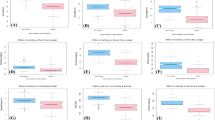Summary
The potential to improve seed germination responses to salinity was evaluated for 13 accessions representing six wild Lycopersicon species and 20 accessions of L. esculentum. Germination response times increased in all accessions at 100 mM NaCl. Analysis indicated that one accession of L. peruvianum (PI126435) germinated faster under high salinity than all other accessions and was closely followed by L. pennellii (LA716). The fastest germinating L. esculentum accession, PI174263, ranked third. Additional wild ecotypes exhibiting rapid germination at 100 mM NaCl were identified among L. pimpinellifolium and L. peruvianum.
Similar content being viewed by others

References
Abel, G.H. & A. J., Mackenzie, 1964. Salt tolerance of soybean varieties L. Glycine max L. (Merrill) during germination and later growth. Crop Sci. 4: 157–161.
Bernstein, L. & H. A., Hayward, 1958. Physiology of salt tolerance. Ann. Rev. Plant Phys. 9: 25–46
Black, C. A., 1968. Soil-plant relationships. 2nd ed. Wiley, New York. 792 pp.
Bohn, H. L., B. L., McNeal & G. A., O'Connor, 1979. Soil chemistry, John Wiley and Sons, New York.
Dehan, K. & M., Tal, 1978. Salt tolerance in the wild relatives of the cultivated tomato: responses of Solanum pennellii to high salinity. Irrig. Sci. 1: 71–76.
Esashi, Y. & A. C., Leopold, 1968. Physical forces in dormancy and germination of Xanthium seeds. Plant Physiol. 43: 871–876.
Greenway, H. & R., Munns, 1980. Mechanisms of salt tolerance in nonhalophytes. Annu. Rev. Plant Physiol. 31: 149–190.
Hegarty, T. W., 1978. The physiology of seed hydration and dehydration, and the relation between water stress and the control of germination: a review. Plant, Cell and Env. 1: 101–119.
Jones, R. A. & C. O., Qualset, 1984. Breeding crops for environmental stress tolerance. In: Collins, G. B. & J. F., Petolino (Eds), Application of genetic engineering to crop improvement. Nijhoff/Junk Publishers, Holland. pp. 305–340.
Levitt, J., 1980. Responses of plants to environmental stresses. Academic Press, New York.
Phills, B. R., N. H., Peck, G. E., MacDonald & R. W., Robinson, 1979. Differential reponses of Lycopersicon and Solanum species to salinity. J. Am. Soc. Hort. Sci. 104: 349–352.
Rick, C. M., 1973. Potential genetic resources in tomato species: clues from observations in native habitats. In: Srb, A. M. (Ed.). Genes, enzymes and populations, Plenum, New York, pp. 255–269.
Rush, D. W. & E., Epstein, 1976. Genotypic responses to salinity: differences between salt-sensitive and salt-tolerant genotypes of the tomato. Plant Physiol. 57: 162–166.
Rush, D. E. & E., Epstein, 1981. Comparative studies on the sodium, potassium and cloride relations of a wild halophytic and a domestic salt-senstive tomato species. Plant Physiol. 68: 1308–1313.
Scott, S. J. & R. A., Jones, 1982. Low temperature seed germination of Lycopersicon species evaluated by survival analysis. Euphytica 31: 869–883.
Scott, S. J., R. A., Jones & W. A., Williams, 1984. Review of data analysis methods for seed germination. Crop Sci. 248: 1192–1199.
Tal, M., 1971. Salt tolerance in the wild relatives of the cultivated tomato: responses of Lycopesicon esculentum, L. peruvianum and L. esculentum minor to sodium chloride solution. uust. J. Agric. Res. 22: 631–638.
Tal, M. & V., Gavish, 1973. Salt tolerance in the wild relatives of the cultivated tomato: water blance and abscisic acid in Lycopersicon esculentum and L. peruvianum under low and high salinity. Aust. J. Agric. Res. 24: 353–361.
Tal, M. & M. C., Shannon, 1983. Salt tolerance in the wild relatives of the cultivated tomato: Responses of Lycopersicon esculentum, L. cheesmanii, L. peruvianum, Solanum pennellii and F1 hybrids to high salinity. Aust. J. Plant Physiol. 10: 109–117.
Ungar, I. A., 1978. Halophyte seed germination. Bot. Rev. 44: 233–264.
Author information
Authors and Affiliations
Rights and permissions
About this article
Cite this article
Jones, R.A. High salt tolerance potential in Lycopersicon species during germination. Euphytica 35, 575–582 (1986). https://doi.org/10.1007/BF00021866
Received:
Issue Date:
DOI: https://doi.org/10.1007/BF00021866



